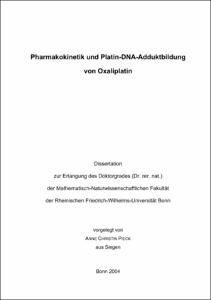Pharmakokinetik und Platin-DNA-Adduktbildung von Oxaliplatin

Pharmakokinetik und Platin-DNA-Adduktbildung von Oxaliplatin

| dc.contributor.advisor | Jaehde, Ulrich | |
| dc.contributor.author | Pieck, Anne Christin | |
| dc.date.accessioned | 2020-04-06T20:46:08Z | |
| dc.date.available | 2020-04-06T20:46:08Z | |
| dc.date.issued | 2004 | |
| dc.identifier.uri | https://hdl.handle.net/20.500.11811/2078 | |
| dc.description.abstract | Oxaliplatin, ein Platinkomplex der dritten Generation, zeichnet sich durch gute antitumorale Wirksamkeit aus. Aufgrund fehlender Kreuzresistenz zu anderen in der Therapie etablierten Platinkomplexen und des günstigen Toxizitätsprofils wird die Substanz breit eingesetzt, vor allem bei kolorektalen Karzinomen, aber auch bei anderen Tumorentitäten im Rahmen klinischer Studien. Die dosislimitierende Toxizität von Oxaliplatin besteht in einer sensorischen peripheren Neuropathie. In der vorliegenden Arbeit wurden die Platinpharmakokinetik und die Platin-DNA-Adduktbildung in Leukozyten untersucht und die Variabilität der bestimmten Parameter charakterisiert. Weiterhin wurden patientenindividuelle Faktoren hinsichtlich ihres Einflusses auf die Pharmakokinetik und dynamik geprüft. Außerdem wurde untersucht, in wie weit Zusammenhänge zwischen pharmakokinetischen Parametern und dem Ausmaß der DNA-Platinierung einerseits und klinischen Effekten wie Tumoransprechen und therapieassoziierter Toxizität andererseits bestehen. Die Untersuchung der Platin-Konzentrations-Zeit-Verläufe in Ultrafiltrat, Plasma, Vollblut und Erythrozyten erfolgte mittels einer validierten flammenlosen Atomabsorptionsspektrometrie-Methode. Für die Quantifizierung der Platin-DNA-Addukte wurden zunächst Leukozyten aus Vollblut und dann aus diesen die DNA isoliert. Danach erfolgte die Quantifizierung der DNA mittels UV-Spektrometrie sowie des an die DNA gebundenen Platins mittels adsorptiver Voltammetrie. In Kooperation mit 6 Kliniken wurden insgesamt 52 Patienten untersucht, die mit vier unterschiedlichen oxaliplatinhaltigen Kombinationstherapien behandelt wurden. Vor, während und nach der Oxaliplatininfusion wurden 6 bis 15 Blutproben pro Patient und Zyklus entnommen. In den Matrizes Ultrafiltrat, Plasma, Vollblut und Erythrozyten wurden die Platin-Konzentrations-Zeit-Verläufe mit Hilfe von Kompartiment-Modellen pharmakokinetisch ausgewertet. Als Einflussfaktoren auf die Platinpharmakokinetik konnten Gewicht, Geschlecht, Körperoberfläche und die Nierenfunktion ermittelt werden. Weiterhin konnten Zusammenhänge zwischen der Platinexposition in Erythrozyten und der Toxizität beobachtet werden. Verglichen mit den pharmakokinetischen Parametern war die interindividuelle Variabilität der DNA-Platinierung in Leukozyten sehr hoch. Als Einflussfaktor auf das Ausmaß der Adduktbildung konnte das Geschlecht identifiziert werden. Neben einem Zusammenhang der maximalen Platin-Nukleotid-Verhältnisse mit der Neurotoxizität wurde festgestellt, dass die DNA-Platinierung 48 h nach Infusionsbeginn für Patienten mit Response höher war als für Non-Responder. Falls sich dieser Sachverhalt in größeren Studien bestätigt, könnten Adduktmessungen zur Therapieindividualisierung eingesetzt werden. | en |
| dc.description.abstract | Pharmacokinetics and platinum-DNA adduct formation of oxaliplatin Oxaliplatin, a third generation platinum complex, shows activity against various tumours. Because of the lacking cross resistance to cisplatin and carboplatin and an advantageous toxicity profile oxaliplatin is broadly used for the treatment of metastatic colorectal cancer and other tumour entities within clinical studies. The dose-limiting toxicity is a peripheral sensory neurotoxity. In this work the platinum pharmacokinetics and the platinum-DNA adduct formation in white blood cells were investigated. Furthermore, the interindividual variability of the pharmacokinetic and pharmacodynamic parameters and the influence of patient-specific factors were assessed. Additionally, correlations between pharmacokinetic parameters and the extent of DNA platination and clinical effects, e.g. therapy-associated toxicity or response, were investigated. The quantification of platinum concentrations in ultrafiltrate, plasma, whole blood and erythrocytes was performed by a validated flameless atomic absorption spectrometry method. For the determination of platinum DNA-adduct formation DNA was extracted from white blood cells which were isolated from whole blood by density gradient centrifugation. Afterwards, the DNA was quantified by UV spectrometry and the platinum bound to DNA by adsorptive voltammetry. In cooperation with 6 clinical centers 52 patients were investigated, who were treated with four different oxaliplatin-containing regimens. Before, during and after the oxaliplatin infusion 6 to 15 whole blood samples were collected per patient and treatment cycle. In ultrafiltrate, plasma, whole blood and erythrocytes the platinum concentration-time profiles were analysed by compartimental data analysis. Platinum pharmacokinetics was influenced by several patient-specific factors like body weight, sex, body surface area and renal function. Furthermore, correlations between platinum exposure in erythrocytes and toxicity were observed. In comparision to the pharmacokinetic parameters the interindividual variability of DNA platination in white blood cells was relatively large. The extent of DNA adduct formation was influenced by sex. The maximum platinum-nucleotide ratios were correlated to the severity of neurotoxicity. Furthermore, the DNA platination 48 h after start of the oxaliplatin infusion was higher for patients with tumour response compared to non-responders. If these correlations are confirmed in larger trials the measurement of adduct levels may be used for treatment individualization. | en |
| dc.language.iso | deu | |
| dc.rights | In Copyright | |
| dc.rights.uri | http://rightsstatements.org/vocab/InC/1.0/ | |
| dc.subject | Oxaliplatin | |
| dc.subject | Pharmakokinetik | |
| dc.subject | DNA | |
| dc.subject | Addukte | |
| dc.subject | Platin | |
| dc.subject | pharmacokinetics | |
| dc.subject | adducts | |
| dc.subject | platinum | |
| dc.subject.ddc | 500 Naturwissenschaften | |
| dc.title | Pharmakokinetik und Platin-DNA-Adduktbildung von Oxaliplatin | |
| dc.type | Dissertation oder Habilitation | |
| dc.publisher.name | Universitäts- und Landesbibliothek Bonn | |
| dc.publisher.location | Bonn | |
| dc.rights.accessRights | openAccess | |
| dc.identifier.urn | https://nbn-resolving.org/urn:nbn:de:hbz:5N-04156 | |
| ulbbn.pubtype | Erstveröffentlichung | |
| ulbbnediss.affiliation.name | Rheinische Friedrich-Wilhelms-Universität Bonn | |
| ulbbnediss.affiliation.location | Bonn | |
| ulbbnediss.thesis.level | Dissertation | |
| ulbbnediss.dissID | 415 | |
| ulbbnediss.date.accepted | 15.06.2004 | |
| ulbbnediss.fakultaet | Mathematisch-Naturwissenschaftliche Fakultät | |
| dc.contributor.coReferee | Wiese, Michael |
Files in this item
This item appears in the following Collection(s)
-
E-Dissertationen (4465)




